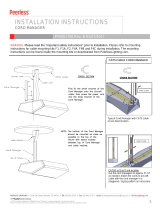
DDC4 (Double Mount - Ceiling) .......................................................................................................... 19
Setting the Time............................................................................................................................................ 20
Time Formats............................................................................................................................................ 20
12 Hour Format..................................................................................................................................... 20
24 Hour Format..................................................................................................................................... 20
Appendix A - DDC2-RS / 4-RS Secondary Clock Wiring Diagrams........................................................... 21
Stand-Alone (115VAC) ............................................................................................................................ 21
3-Wire Synchronous (115VAC) ............................................................................................................... 22
3-Wire Synchronous (24VAC) ................................................................................................................. 23
3-Wire minute Impulse (59
th
Minute) ....................................................................................................... 24
3-Wire Minute Impulse (59
th
Minute With 12 Hour Correction).............................................................. 25
Standard Electric Synchronous ................................................................................................................. 26
Standard Electric AR-2A 2-Wire Dual Voltage........................................................................................ 27
Standard Electric AR-2 2-Wire Dual Voltage........................................................................................... 28
Synchronous Wired................................................................................................................................... 29
Simplex 59
th
Minute Dual Motor .............................................................................................................. 30
Simplex 45
th
Minute Dual Motor .............................................................................................................. 31
Edwards Dual Motor................................................................................................................................. 32
Standard Electric AR-3 3-Wire Minute Impulse....................................................................................... 33
National Synchronous Wired .................................................................................................................... 34
Stromberg Synchronous Wired (56
th
Minute)........................................................................................... 35
Cincinnati D1 ............................................................................................................................................ 36
Cincinnati D6, Edwards 2406 ................................................................................................................... 37
2-Wire Pulse Alternating (24VDC) .......................................................................................................... 38
Electronic Coded....................................................................................................................................... 39
Straight Frequency .................................................................................................................................... 40
3-Wire Minute Impulse (58
th
Minute)....................................................................................................... 41
3-Wire Minute Impulse (44
th
Minute)....................................................................................................... 42
2-Wire Reverse Polarity Minute Impulse (59
th
Minute) ........................................................................... 43
Appendix B - DDC2-RS-24 / DDC4-RS-24 Wiring..................................................................................... 44
DDC2-RS-24 / DDC4-RS-24 Wiring ....................................................................................................... 45
Appendix C - RS485 Wiring Diagrams ........................................................................................................ 46
RS485 Data Format................................................................................................................................... 46
OMCII to DDC2-RS / 4-RS...................................................................................................................... 47
LTR0 to DDC2-RS / 4-RS ........................................................................................................................ 48
LTR4 / 8-512 to DDC2-RS / 4-RS............................................................................................................ 49
Appendix D - DDC-TC Timer Control Panel ............................................................................................... 50
Wiring ....................................................................................................................................................... 50
Installation ................................................................................................................................................ 51
Operation .................................................................................................................................................. 52
























